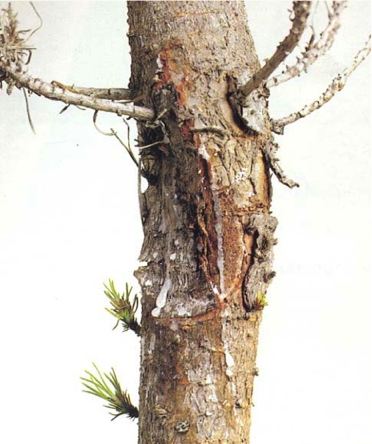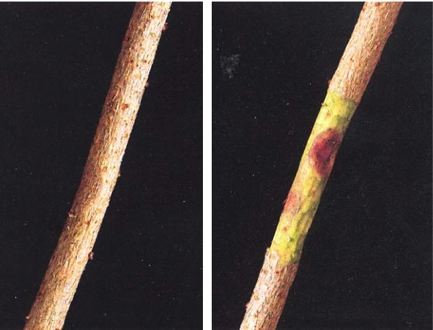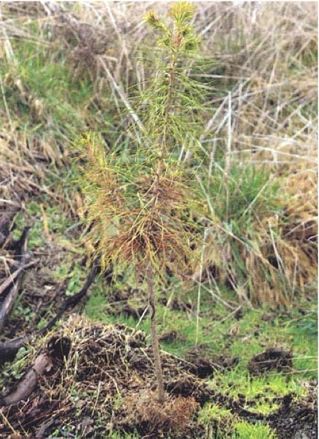PESTS AND DISEASES OF FORESTRY IN NEW ZEALAND
Bacterial stem canker
Scion is the leading provider of forest-related knowledge in New Zealand
Formerly known as the Forest Research Institute, Scion has been a leader in research relating to forest health for over 50 years. The Rotorua-based Crown Research Institute continues to provide science that will protect all forests from damage caused by insect pests, pathogens and weeds. The information presented below arises from these research activities.
Bacterial stem canker,
Forest Pathology in New Zealand No. 10.
Based on M. Dick 1984
Compiled: 1985, limited revision 2001, revised 2009.
Causal organism
Pseudomonas syringae pv. syringae van Hall 1902

Fig. 1 - Large resinous canker on stem of Pinus radiata infected by Pseudomonas syringae pv. syringae.
Type of injury
Cankers (sunken patches of dead tissue) form on the stem of young plants and may cause their death.
Diagnostic features
- Cankers on lower stem. These range from small, sunken patches (Fig. 2 and 3) to large, distorted, resinous areas (Fig. 1) which may girdle the stem.
- Condition generally confined to l-year-old trees.
- Foliage fades in colour and wilts prior to death of plant (Fig. 4).
- Damage occurs during the winter months.
Host
Pinus radiata .
Distribution
Bacterial stem canker has been confirmed in both North and South Islands from Bay of Plenty south.
Disease development
Bacterial stem canker occurs only in winter and its incidence is thought to be dependent on a particular sequence of weather conditions. Pseudomonas syringae pv. syringae has the property of being able to act as an ice nucleus and to initiate the formation of ice crystals. This causes more damage to plant tissue than normal frosts. Pseudomonas syringae pv. syringae can also invade such damaged tissue. The disease is therefore favoured by a period of frosts suddenly following a time of mild, wet weather which has prevented plants from hardening off. This type of stem canker is most frequently found on plants growing in hollows and on flats which are prone to cold-air ponding. Trees growing on grassy, fertile sites appear more susceptible than those on clear ground, probably because the presence of ground cover can lower the temperature by as much as 4oC.
Cankers caused by Pseudomonas syringae pv. syringae commonly occur on the lower stem of plants below the bottom whorl of branches, though they may sometimes be found higher up the stem. They range in size from small, sunken patches of dead tissue only a few millimetres in diameter to large, distorted, resinous areas which in severe cases completely girdle the stem, resulting in wilting of foliage and finally the death of the plant. The small cankers, which have little or no effect on the growth and vitality of the tree, and the larger ones which do not produce resin become more apparent when the bark is removed to reveal the dead tissue beneath (Fig. 2 and 3). Affected plants may also show signs of frost damage, such as needle scorching or dead buds.

Fig. 2, 3 - Small canker caused by Pseudomonas syringae . Left: Young stem with a barely visible sunken patch. Right: Same branch with bark removed to reveal dead tissue.
Bacterial stem canker is generally confined to l-year-old plants though 2-year-old plants are sometimes susceptible.
Plants which do not die in the few months following the initial infection seldom show any further deterioration. With the onset of spring growth, callus tissue begins to cover the dead tissue of the cankered part of the stem, and after 3 or 4 growing seasons have passed, even trees which have been three-quarters girdled show no signs of the previous damage. Badly cankered trees are, however, prone to breakage at the site of the canker in the first year after infection. In those cases where cankers develop in the mid-stem region, branches below the canker may take over to form new leaders, giving the tree a poor form.
Economic importance
The disease is of only sporadic occurrence and is not considered to be of any great importance. Severe losses have, however, occurred: for example, in the winter of 1977 two sites in the central North Island with a combined area of approximately 200 hectares had 35% infection, and 50% of infected plants died as a result of stem girdling.

Fig. 4 - Fading and wilting in young Pinus radiata infected by bacterial stem canker.
Control
Direct control of the pathogen is not practical. However, on fertile, frost-prone sites, removal of ground cover around individual plants may reduce the risk of bacterial canker by preventing additional temperature lowering during frosts.
Notes : Pseudomonas syringae pv. syringae is a very common and widespread organism and different forms are pathogenic on a wide range of hosts. Besides causing stem canker disease in 1-year-old Pinus radiata, the organism can also cause dieback in nursery seedlings.
Bibliography
Dick, M. 1985: Bacterial stem canker. New Zealand Forest Service, Forest Pathology in New Zealand No. 10.
This information is intended for general interest only. It is not intended to be a substitute for specific specialist advice on any matter and should not be relied on for that purpose. Scion will not be liable for any direct, indirect, incidental, special, consequential or exemplary damages, loss of profits, or any other intangible losses that result from using the information provided on this site.
(Scion is the trading name of the New Zealand Forest Research Institute Limited.)

 Farm Forestry New Zealand
Farm Forestry New Zealand

